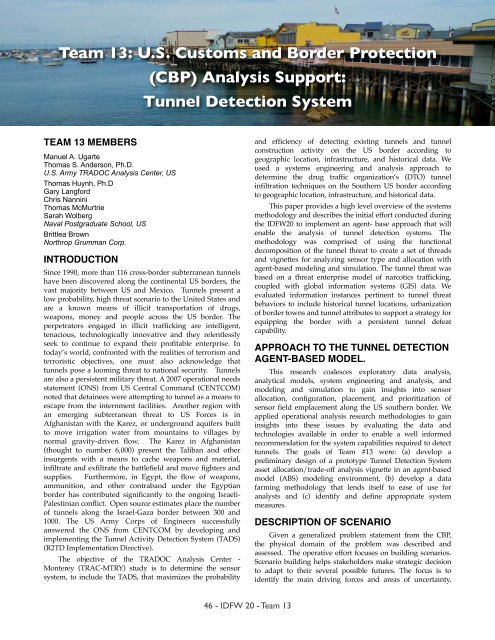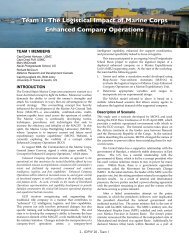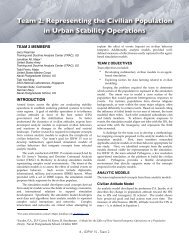pdf file - SEED Center for Data Farming - Naval Postgraduate School
pdf file - SEED Center for Data Farming - Naval Postgraduate School
pdf file - SEED Center for Data Farming - Naval Postgraduate School
You also want an ePaper? Increase the reach of your titles
YUMPU automatically turns print PDFs into web optimized ePapers that Google loves.
Team 13: U.S. Customs and Border Protection<br />
(CBP) Analysis Support:<br />
Tunnel Detection System<br />
TEAM 13 MEMBERS<br />
Manuel A. Ugarte<br />
Thomas S. Anderson, Ph.D.<br />
U.S. Army TRADOC Analysis <strong>Center</strong>, US<br />
Thomas Huynh, Ph.D<br />
Gary Lang<strong>for</strong>d<br />
Chris Nannini<br />
Thomas McMurtrie<br />
Sarah Wolberg<br />
<strong>Naval</strong> <strong>Postgraduate</strong> <strong>School</strong>, US<br />
Brittlea Brown<br />
Northrop Grumman Corp.<br />
INTRODUCTION<br />
Since 1990, more than 116 cross-border subterranean tunnels<br />
have been discovered along the continental US borders, the<br />
vast majority between US and Mexico. Tunnels present a<br />
low probability, high threat scenario to the United States and<br />
are a known means of illicit transportation of drugs,<br />
weapons, money and people across the US border. The<br />
perpetrators engaged in illicit trafficking are intelligent,<br />
tenacious, technologically innovative and they relentlessly<br />
seek to continue to expand their profitable enterprise. In<br />
today’s world, confronted with the realities of terrorism and<br />
terroristic objectives, one must also acknowledge that<br />
tunnels pose a looming threat to national security. Tunnels<br />
are also a persistent military threat. A 2007 operational needs<br />
statement (ONS) from US Central Command (CENTCOM)<br />
noted that detainees were attempting to tunnel as a means to<br />
escape from the internment facilities. Another region with<br />
an emerging subterranean threat to US Forces is in<br />
Afghanistan with the Karez, or underground aquifers built<br />
to move irrigation water from mountains to villages by<br />
normal gravity-driven flow. The Karez in Afghanistan<br />
(thought to number 6,000) present the Taliban and other<br />
insurgents with a means to cache weapons and material,<br />
infiltrate and exfiltrate the battlefield and move fighters and<br />
supplies. Furthermore, in Egypt, the flow of weapons,<br />
ammunition, and other contraband under the Egyptian<br />
border has contributed significantly to the ongoing Israeli-<br />
Palestinian conflict. Open source estimates place the number<br />
of tunnels along the Israel-Gaza border between 300 and<br />
1000. The US Army Corps of Engineers successfully<br />
answered the ONS from CENTCOM by developing and<br />
implementing the Tunnel Activity Detection System (TADS)<br />
(R2TD Implementation Directive).<br />
The objective of the TRADOC Analysis <strong>Center</strong> -<br />
Monterey (TRAC-MTRY) study is to determine the sensor<br />
system, to include the TADS, that maximizes the probability<br />
and efficiency of detecting existing tunnels and tunnel<br />
construction activity on the US border according to<br />
geographic location, infrastructure, and historical data. We<br />
used a systems engineering and analysis approach to<br />
determine the drug traffic organization’s (DTO) tunnel<br />
infiltration techniques on the Southern US border according<br />
to geographic location, infrastructure, and historical data.<br />
This paper provides a high level overview of the systems<br />
methodology and describes the initial ef<strong>for</strong>t conducted during<br />
the IDFW20 to implement an agent- base approach that will<br />
enable the analysis of tunnel detection systems. The<br />
methodology was comprised of using the functional<br />
decomposition of the tunnel threat to create a set of threads<br />
and vignettes <strong>for</strong> analyzing sensor type and allocation with<br />
agent-based modeling and simulation. The tunnel threat was<br />
based on a threat enterprise model of narcotics trafficking,<br />
coupled with global in<strong>for</strong>mation systems (GIS) data. We<br />
evaluated in<strong>for</strong>mation instances pertinent to tunnel threat<br />
behaviors to include historical tunnel locations, urbanization<br />
of border towns and tunnel attributes to support a strategy <strong>for</strong><br />
equipping the border with a persistent tunnel defeat<br />
capability.<br />
APPROACH TO THE TUNNEL DETECTION<br />
AGENT-BASED MODEL.<br />
This research coalesces exploratory data analysis,<br />
analytical models, system engineering and analysis, and<br />
modeling and simulation to gain insights into sensor<br />
allocation, configuration, placement, and prioritization of<br />
sensor field emplacement along the US southern border. We<br />
applied operational analysis research methodologies to gain<br />
insights into these issues by evaluating the data and<br />
technologies available in order to enable a well in<strong>for</strong>med<br />
recommendation <strong>for</strong> the system capabilities required to detect<br />
tunnels. The goals of Team #13 were: (a) develop a<br />
preliminary design of a prototype Tunnel Detection System<br />
asset allocation/trade-off analysis vignette in an agent-based<br />
model (ABS) modeling environment, (b) develop a data<br />
farming methodology that lends itself to ease of use <strong>for</strong><br />
analysts and (c) identify and define appropriate system<br />
measures.<br />
DESCRIPTION OF SCENARIO<br />
Given a generalized problem statement from the CBP,<br />
the physical domain of the problem was described and<br />
assessed. The operative ef<strong>for</strong>t focuses on building scenarios.<br />
Scenario building helps stakeholders make strategic decision<br />
to adapt to their several possible futures. The focus is to<br />
identify the main driving <strong>for</strong>ces and areas of uncertainty.<br />
46 - IDFW 20 - Team 13




